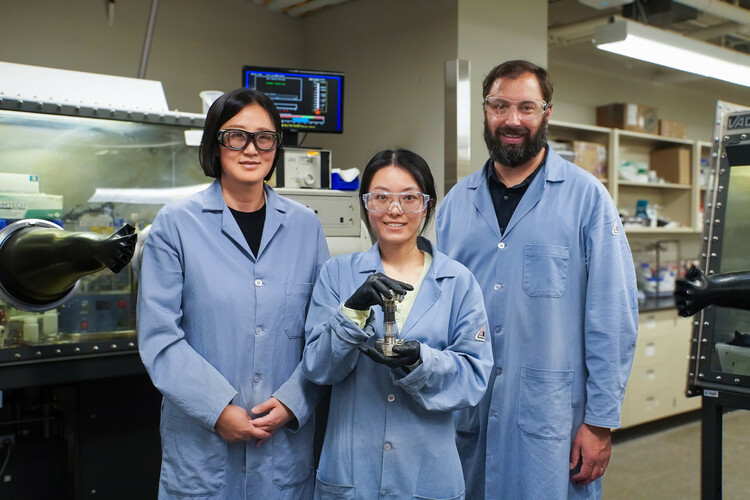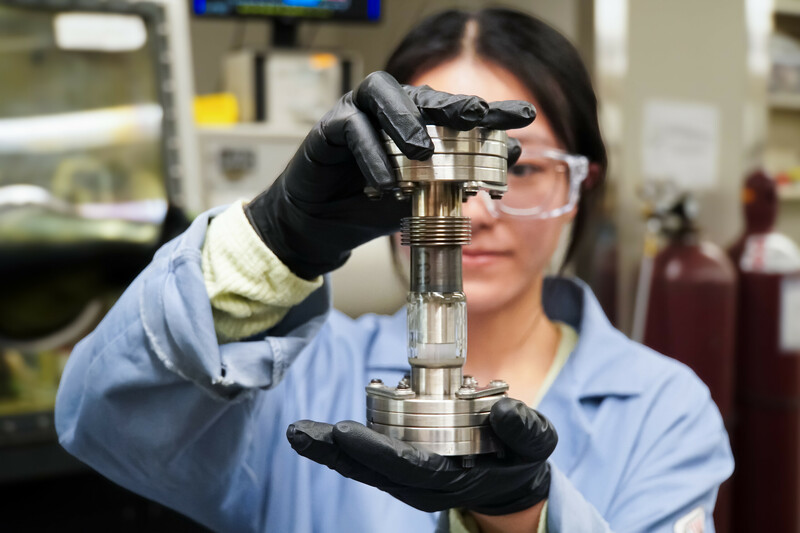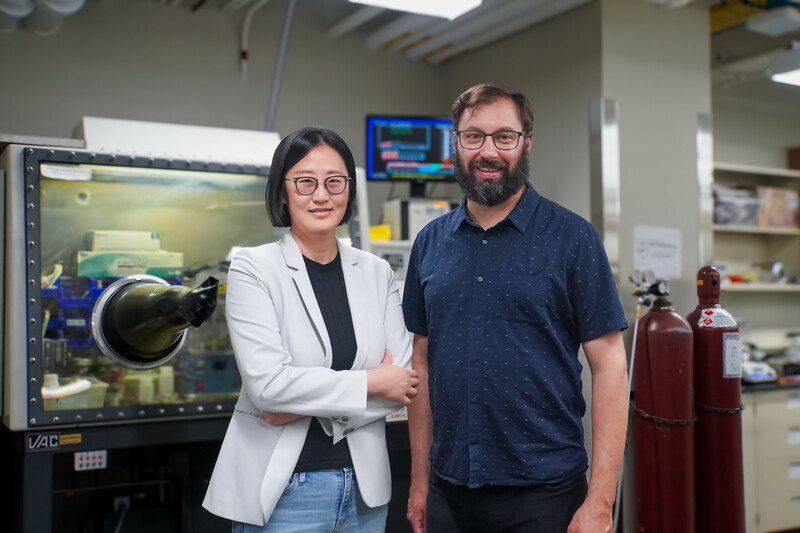Accelerating Energy Storage: The Chemistry of a Solid-State Battery
Posted on
L-R: Dr. Lingzi Sang, Runqi Wu, and .Runqi holding a conflat-style cell, a device that can measure the creep deformation of a solid-state battery composed of the composite electrolyte.
Dr. Lingzi Sang has embarked on a journey at the intersection of analytical, materials, and inorganic chemistry. The motivation behind her quest? To unravel the molecular intricacies of energy storage for renewable energy resources, particularly in the form of batteries. Lingzi's team tackles challenges such as conductivity and mechanical issues, envisioning a future where solid-state batteries can revolutionize energy storage.
Lingzi's research career began at the University of Arizona, where she completed her doctorate followed by three years of postdoctoral research at the University of Illinois at Urbana-Champaign. Surrounded by colleagues immersed in independent research careers, Lingzi found herself at a crossroads between industry research and development and the academic world. Opting for academia, she discovered a profound love for teaching, primarily fueled by the boundless enthusiasm of her students.
In 2018, Lingzi started teaching electrochemistry, spectroscopy, and analytical instrumentation at the University of Alberta’s Department of Chemistry. Just before the COVID-19 pandemic in 2020, Lingzi found herself in a whirlwind of change as she started a family and found herself with a brand-new batch of students facing a worldwide pandemic.
“My students were so prepared to begin their lab work, but because of the pandemic, all that was put on hold,” she recalls. “It was a unique experience, and definitely a challenge. But when we eventually did go back in person, there was more excitement than ever before. And the added pressure of the uncertainty at the time also helped me discover my own strength and resilience as a chemist.”
When Lingzi first started as a professor, she discovered significant differences in jargon between students without backgrounds in chemistry and physics. However, through communication, feedback, and a little practice—skills she picked up as a new mother—Lingzi adapted her approach to teaching.
“I learned to adjust the way I explain things and the language I use with my students,” she says. “They remind me of my daughter sometimes, so eager, brave, and hopeful, and it’s such fun to explore science through their eyes.”

Researching Solid-state batteries
Lingzi’s research in the Department of Chemistry focuses on the efficiency of energy storage systems. More specifically, her research mandate is to characterize and understand the chemical processes within electrochemical cells, or batteries. The team aims to answer questions such as the storage capacity of electric vehicle (EV) batteries, their recharging time, and how many charge cycles a single battery can support.
Lingzi examines the molecular level of the decomposition processes that jeopardize battery longevity and performance. One method of doing this is examining an operating battery with vibrational spectroscopy. The measurement approach recognizes single and multiple molecular compositions similar to the unwanted products resulting from decomposition.
In the process designed by her research team for the solid-state batteries, vibrational spectroscopy recognizes the sodium-antimony binary compound as an unwanted product. Beyond diagnosis, Lingzi’s students are using information obtained from analysis to design protective materials that specifically prevent unwanted degradation.
One benefit of solid-state batteries that her team, and the rest of the battery community, has already isolated is the wider operating temperature ranges compared to liquid batteries. Lingzi is also testing out new materials for solid-state batteries that offer other benefits. For example, electrodes composed of sulphide materials offer a slight environmental benefit over current EV batteries composed of hard-to-obtain metals like cobalt and lithium.
Her newest project, funded by the Future Energy Systems Accelerator Fund, involves the development of compact, high-energy solid batteries. These batteries enhance safety of the entire battery system by eliminating volatile organic electrolytes prone to explosions, like those currently found in EV batteries.
“Current EV batteries use carbon-based liquid electrolytes that have very low sparking points and burn at much hotter temperatures,” Lingzi explains. “An explosion or fire in this type of cell can quickly spread to neighbouring cells, causing a chain reaction that easily becomes out of control. These fires take much longer and more resources to put out than traditional fires, due to their quickly-escalating and random nature. This is a big concern for EV batteries during and after their service life.”

When one problem is solved, another may appear
Despite significant progress, Lingzi acknowledges that these batteries are still in their infancy. Solid-state batteries are not yet marketable because of their extremely bulky structure, and their limited cycling performance, neither of which cannot yet compete with commercial-grade lithium-ion batteries.
But Lingzi’s relentless pursuit continues, with the long-term goal of scalable solutions and eventual commercialization. Her team has been experimenting with polymers to bind mechanically-enhanced solid electrolytes, allowing for thinner cells packed more compactly that don’t lose conductivity or efficiency.
In the past two years, they have successfully synthesized a thin electrolyte enabled by polymer bindings. At the current point in her research, Lingzi and her team have developed batteries and have implemented them into two systems where they’re already successfully functioning.
“The electrolytes are working well now, but we still need to improve the chemistry of the interfacial protective layers and contact with the electrodes inside the battery. Then we’ll be ready for scale-up and the commercial market,” Lingzi says.
Looking forward, Lingzi understands the importance of these processes being compatible with future industry development and scale-up. In the next phase of her research, she’s testing out alternative binding materials, experimenting more energy- and cost-effective solution processing approaches, and perfecting a working prototype.
“Ductility is still a major challenge, but in theory, once the electrolyte is thin enough, we should be able to stack more solid cells together,” Lingzi states. “Think of adding more potatoes to the potato-battery circuit to increase generated power,” she states. “But in this case, the heaviness of a more compact battery is preferable to the bulkiness of bigger cells."
As Lingzi's research continues, her story serves as a reminder of the journey that is scientific inquiry and the ongoing quest for a sustainable energy future. Each discovery is one step closer to her vision of a world powered by innovation, ingenuity, and solid-state batteries.
Watch Dr. Lingzi Sang’s interview with Future Energy Systems on YouTube: Accelerating Energy Storage: The Chemistry of a Solid-State Battery | The Accelerator Project
This story is part of Future Energy System’s Accelerator Project Series. For more information on the Accelerator Projects, click here. To stay up to date with this series, subscribe to our monthly newsletter and follow FES on social media.
Further Reading:
What are the principles of IR spectroscopy/vibrational spectroscopy? | AAT Bioquest